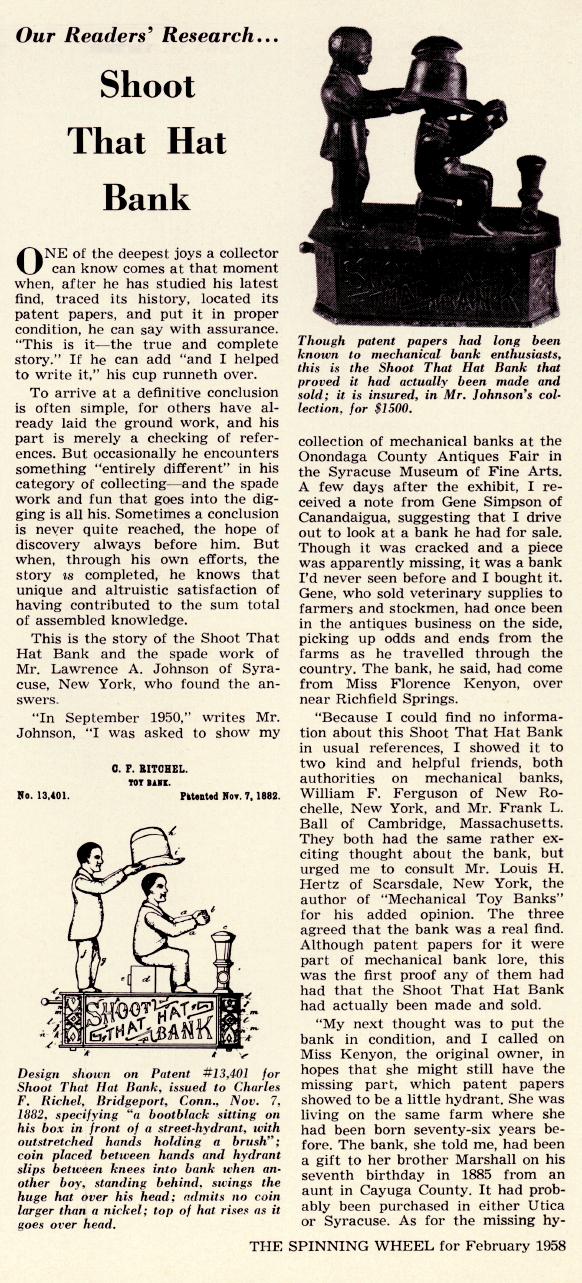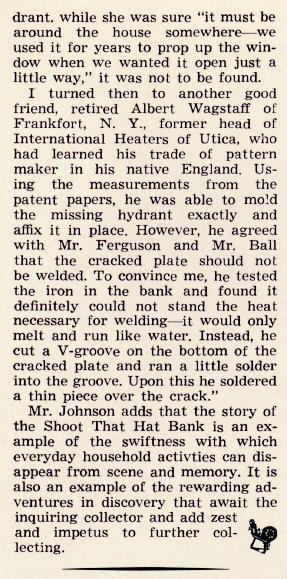| THE SPINNING WHEEL for February 1958, page 34 &
35
(text transcribed below)
 
Our Readers' Research
. .
.
Shoot That Hat Bank
One of the deepest joys a collector can know comes at that moment
when, after he has studied his latest find, traced its history, located its
patent papers, and put it in proper condition, he can say with assurance,
"This is it — the true and complete story." If he can add "and I helped to
write it," his cup runneth over.
To arrive at a definitive
conclusion is often simple, for others have already laid the ground work,
and his part is merely a checking of references. But occasionally he
encounters something "entirely different" in his category of collecting —
and the spade work and fun that goes into the digging is all his. Sometimes
a conclusion is never quite reached, the hope of discovery always before
him. But when, through his own efforts, the story is completed, he knows
that unique and altruistic satisfaction of having contributed to the sum
total of assembled knowledge.
This is the story of the
Shoot That Hat Bank and the spade work of Mr. Lawrence A. Johnson of
Syracuse, New York, who found the answers.
"In September 1950,"
writes Mr. Johnson, "I, was asked to show my collection of mechanical banks
at the Onondaga County Antiques Fair in the Syracuse Museum of Fine Arts. A
few days after the exhibit, I received a note from Gene Simpson of
Canandaigua, suggesting that I drive out to look at a bank he had for sale.
Though it was cracked and a piece was apparently missing, it was a bank I'd
never seen before and I bought it. Gene, who sold veterinary supplies to
farmers and stockmen, had once been in the antiques business on the side,
picking up odds and ends from the farms as he traveled through the country.
The bank, he said, had come from Miss Florence Kenyon, over near Richfield
Springs.
"Because I could find no
information about this Shoot That Hat Bank in usual references, I showed it
to two kind and helpful friends, both authorities on mechanical banks,
William F. Ferguson of New Rochelle, New York, and Mr. Frank L. Ball of
Cambridge, Massachusetts. They both had the same rather exciting thought
about the bank, but urged me to consult Mr. Louis H. Hertz of Scarsdale, New
York, the author of "Mechanical Toy Banks" for his added opinion. The three
agreed that the bank was a real find. Although patent papers for it were
part of mechanical bank lore, this was the first proof any of them had had
that the Shoot That Hat Bank had actually been made and sold.
"My next thought was to
put the bank in condition, and I called on Miss Kenyon, the original owner,
in hopes that she might still have the missing part, which patent papers
showed to be a little hydrant. She was living on the same farm where she had
been born seventy-six years before. The bank, she told me, had been a gift
to her brother Marshall on his seventh birthday in 1885 from an aunt in
Cayuga County. It had probably been purchased in either Utica or Syracuse.
As for the missing hydrant, while she was sure "it must be around the house
somewhere — we used it for years to prop up the window when we wanted it
open just a little way," it was not to be found.
I turned then to another
good friend, retired Albert Wagstaff of Frankfort, N. Y., former head of
International Heaters of Utica, who had learned his trade of pattern maker
in his native England. Using the measurements from the patent papers, he was
able to mold the missing hydrant exactly and affix it in place. However, he
agreed with Mr. Ferguson and Mr. Ball that the cracked plate should not be
welded. To convince me, he tested the iron in the bank and found it
definitely could not stand the heat necessary for welding — it would only
melt and run like water. Instead, he cut a V-groove on the bottom of the
cracked plate and ran a little solder into the groove. Upon this he soldered
a thin piece over the crack.
Mr. Johnson adds that the
story of the Shoot That Hat Bank is an example of the swiftness with which
everyday household activities can disappear from scene and memory. It is
also an example of the rewarding adventures in discovery that await the
inquiring collector and add zest and impetus to further collecting.
(text under images)
Design shown on Patent #13,401 for Shoot That Hat Bank, issued to Charles F.
Richel, Bridgeport, Conn., Nov. 7, 1882, specifying "a bootblack sitting on
his box in front of a street-hydrant, with outstretched hands holding a
brush"; coin placed between hands and hydrant slips between knees into bank
when another boy, standing behind, swings the huge hat over his head; admits
no coin larger than a nickel; top of hat rises as it goes over head.
Though patent papers had long
been known to mechanical bank enthusiasts, this is the Shoot That Hat Bank
that proved it had actually been made and sold; it is insured, in Mr.
Johnson's collection, for $1500.
|